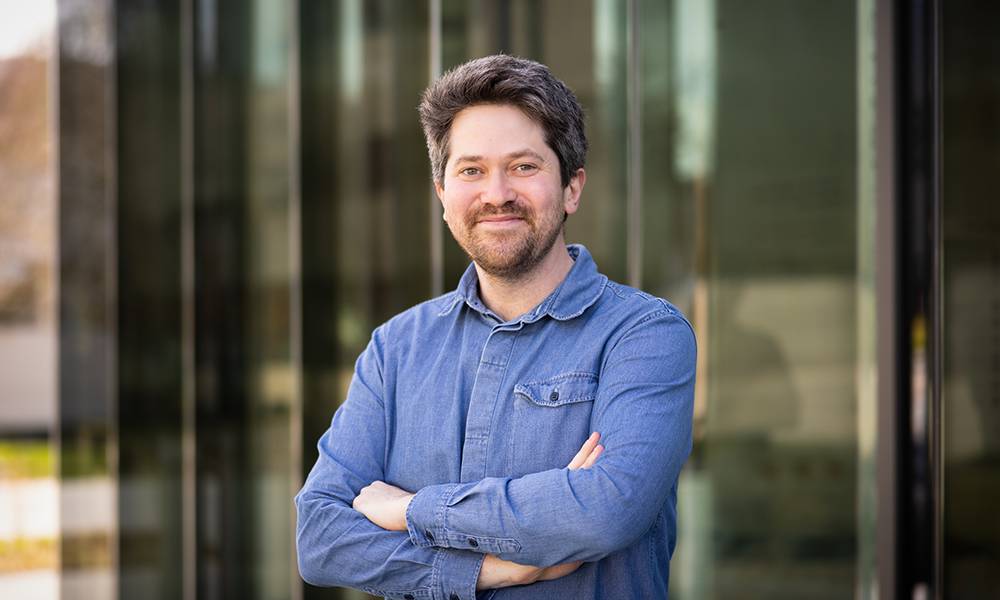
Read the latest Issue
One of EMBL’s newest group leaders studies the fundamental processes that underlie how proteins organise the genome inside the cell

After a postdoctoral stint in Dresden at the Max Planck Institute of Molecular Cell Biology and Genetics and the Max Planck Institute for the Physics of Complex Systems, Thomas Quail joined EMBL as a group leader in November 2022. Motivated by a desire to understand how cells harness ‘collective behaviours’ to achieve the remarkable feat of genome self-organisation, Quail and his group bring a unique interdisciplinary approach to this question, using a combination of single-molecule techniques, quantitative imaging, and theoretical modelling. Here, he chats with us about his scientific journey, his early exposure to the wonders of music, and why EMBL is the right place to carry out his research.
Our lab is interested in dissecting the physical and biochemical principles of genome self-organisation. It’s a classical problem in biology – how do you take an entire genome, roughly two metres or more in length, and package it into an intracellular organelle with a diameter of less than 10 microns? We are trying to understand how this remarkable process of self-organisation occurs by studying it at different length scales and using a variety of complementary approaches.
While the identity of the proteins involved in such processes has been known for some time, their collective behaviour – how they work together – has been more challenging to understand. In the lab, we are using eggs from Xenopus laevis frogs as a model system to investigate this in the context of problems related to genome integrity and chromosomal structure. Our approach is to work across scales. We use molecular techniques to reconstitute intact nuclei in vitro, perform live imaging assays to see them in action, and then drill down using single-molecule biophysical approaches and use quantitative methods to gain a deeper understanding of the whole process.
I first became interested in the problem during my postdoc, where I studied how collections of molecules work together in the context of transcription. My postdoctoral advisor Jan Brugués was really motivated to use physics to understand genome organisation, and this approach and the excitement in the lab about these ideas was contagious. Going back to my PhD days, I’ve always been very fascinated with self-organisation and collective behaviour, and, when I was thinking of scientific questions to address next, this really drew my attention.
Collective behaviour in living systems is not a new concept. First consider any complex system. It is typically made up of individual agents that can interact with each other. If you are looking at just two of these particles, the interactions may seem simple. But by increasing the numbers of agents or changing their geometry, the patterns that form can be very beautiful. This is something that has been known in physics for a long time, but they are also ubiquitous in living systems. Some examples are how molecular motors interact with microtubules leading to the generation of the mitotic spindle apparatus, or how flocks of birds form patterns in the air. These are on very different scales but are all examples of collective behaviour.
I grew up surrounded by a lot of music, and I wanted to follow that path for a long time. At some level, I feel like science and music are connected. But I initially felt drawn to the act of doing science when I joined the lab of my PhD advisor Leon Glass for a summer project. He was really excited about linking mathematics and biology. I was fascinated by this concept that you can describe highly complicated systems with simple models that can help you understand how it works. There’s also the fact that I like working on challenging problems; I think that drew me to science too.
These days I like to walk my dog. She’s a Romanian street dog who looks like a mini German Shepherd. I also enjoy exploring the forest around Heidelberg with my bike though the hills here are tough.
So, this popular science idea of, let’s say, a light bulb suddenly turning on in your brain, or an apple falling on your head, or this lightning bolt of an interesting idea striking you from the middle of nowhere – that’s never been my experience, unfortunately. I think science proceeds more gradually, and with a lot of thought invested in problems over time. But I think there was a moment during my PhD, when I had made a prediction based on a simple model, and when we went back to the data, it matched perfectly. It was of course a very small moment, but deeply satisfying.
Our work is highly interdisciplinary, and it requires expertise from different areas. I feel like that’s really valued at EMBL. This, in turn, allows one to be more creative. There is also a strong emphasis on imaging biological processes, which is quite relevant to my work. In my group we try to take good images, extract meaningful numbers, and then connect these numbers with ideas. EMBL really allows us to do all of these things at a very high level.
Looking for past print editions of EMBLetc.? Browse our archive, going back 20 years.
EMBLetc. archive